Hassani S. Mathematical Physics: A Modern Introduction to Its Foundations
Подождите немного. Документ загружается.

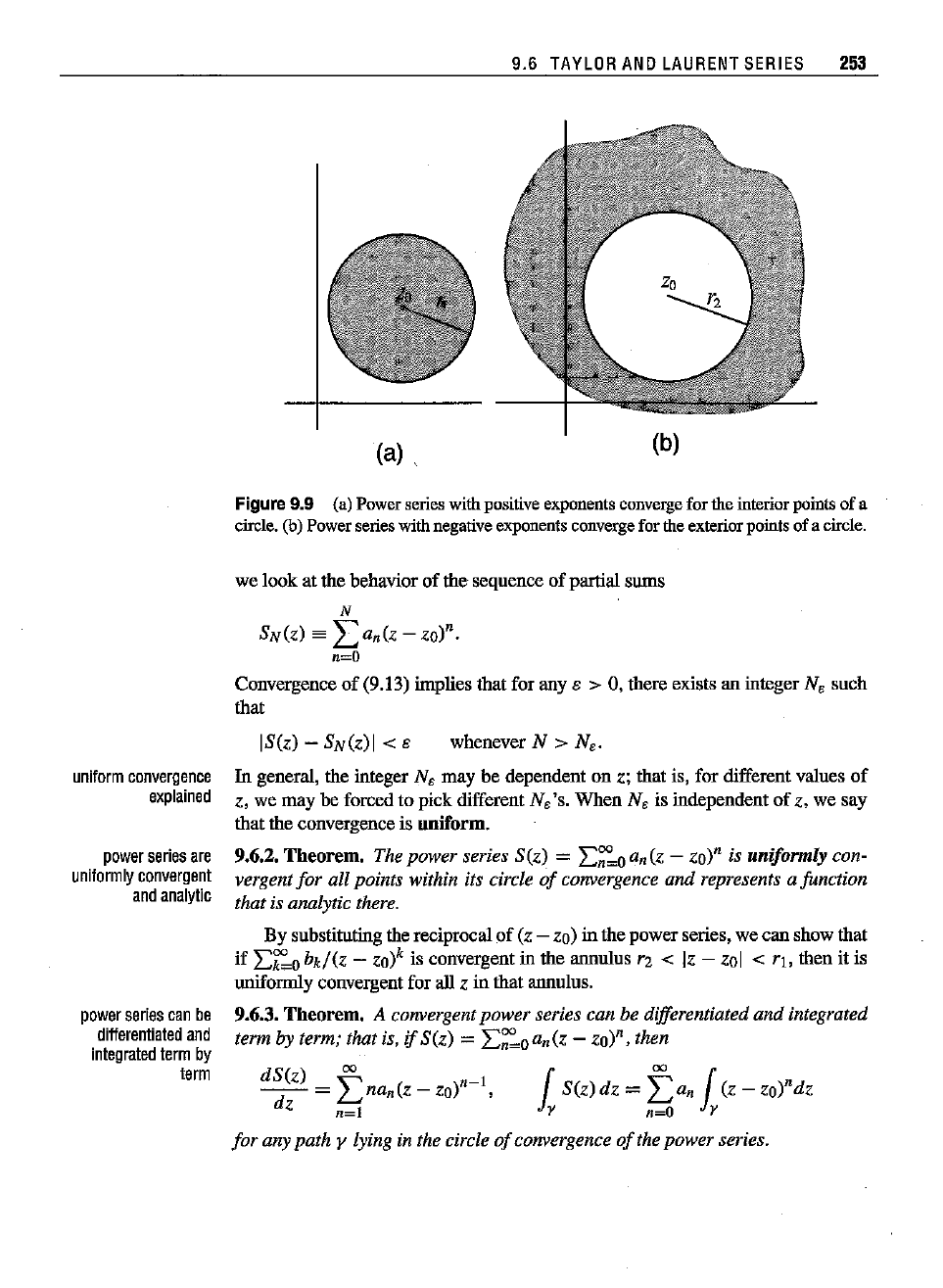
9.6
TAYLOR
ANO
LAURENT
SERIES
253
(a)
Figure
9.9
(a) Power series withpositive exponents converge for the interiorpoints
of
a
circle.
(b)
Power
series
with
negative
exponents
converge
forthe
exterior
points
ofa
circle.
we look at the behavior of the sequence of partial sums
N
SN(Z) es
Ean(z
-
zo)".
n=O
Convergence
of
(9.13) implies that for any 8 > 0, there exists an integer N. such
that
whenever N
> Ns-
uniform
convergence
explained
power
series
are
uniformly
convergent
and
analytic
power
series
can
be
differentiated
and
integrated
term
by
term
In general, the integer
N.
may be dependent on z; that is, for different values
of
z, we may be forced to pick different N. 's. When N. is independent
of
z, we say
that
theconvergence is uniform.
9,6.2. Theorem. The power series S(z) =
L~oan(Z
- ao)" is uniformly con-
vergent for all points within its circle
of
convergence and represents a function
that is analytic there.
By substituting thereciprocal
of
(z - zo) in the power series, we can show that
if
L~o
bk/(z
-
ZO)k
is convergent in the annulus rz < Iz-
zol
<
rl,
then it is
uniformly convergent for
all Z in that annulus.
9.6.3. Theorem. A convergentpower series can be differentiated and integrated
term
by term; that is, ifS(z) =
L~o
an(z- zo)".then
dS(z)
00
1
00
1
~=Enan(z-zo)n-I,
S(z)dz=Ea
n
(z-zo)ndz
n=l
Y n=O Y
for
any path y lying in the circle
of
convergence
of
thepower series.
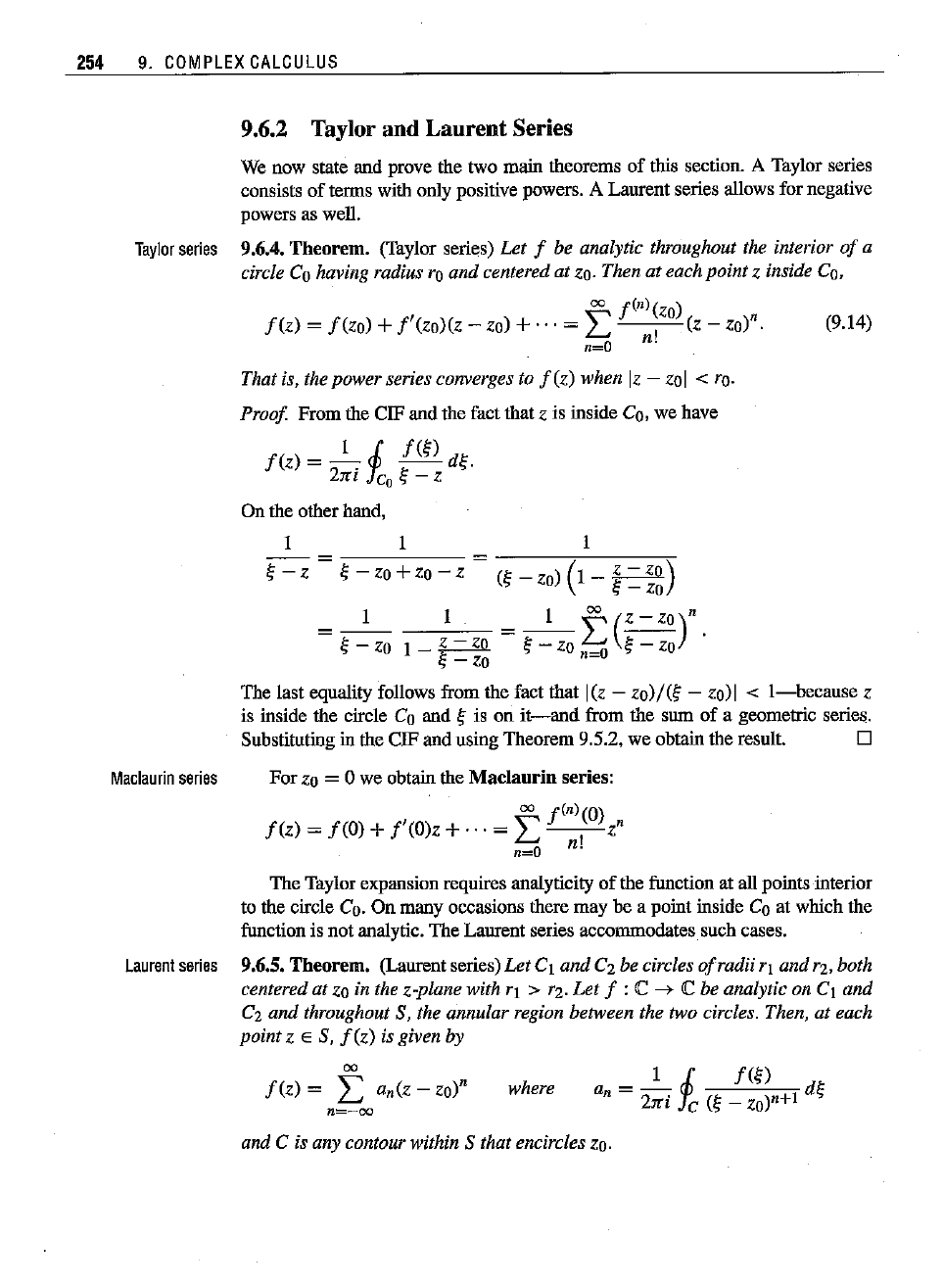
(9.14)
254 9.
COMPLEX
CALCULUS
9.6.2 Taylor and Laurent Series
We now state and prove the two main theorems of this section. A Taylor series
consistsof
terms
withonly positivepowers.A
Laurent
seriesallowsfornegative
powersas well.
Taylor
series
9.6.4.
Theorem.
(Taylor series) Let f be analytic throughout the interior
of
a
circle
Co having radius ro and centered at
zoo
Then at each point z inside Co.
00
f(n)(zo)
f(z)
=
f(zo)
+
f'(zo)(z
-
zo)
+...= L I (z -
zo)".
n=O n.
That is. the powerseries converges to
f(z)
when [z-
zol
<
roo
Proof From the CIF and the fact that z is inside Co, we have
Maclaurin
series
f(z)
=
~
J
f(~)
d~.
2rrl feo
~
- z
On the other hand,
1 1 1
~
- z =
~
- zo +zo - z =
(~_
zo)
(1
_z -
zo)
~
-zo
= 1 1 1
~
(Z
-
ZO)n
~-zo
1-~
=
~-zo~
~-zo
;
-zo
n_O
The last equality follows from the fact that I(z -
zo)/(~
-
zo)1
<
I-because
z
is inside the circle Co and
~
is on
it-and
from the sum of a geometric series.
Substituting in the CIF and using Theorem 9.5.2, we obtain the result. D
For
zo = 0 we obtain the
Maclanrin
series:
00
f(n)(o)
f(z)
= f(O) +J'(O)z +...=L
__
zn
n=O
n!
The Taylor expansion reqnires analyticity
of
the function at all points interior
to the circle Co. On many occasions there may be a point inside Co at which the
function is not analytic. The Laurent series accommodates such cases.
Laurent
series
9.6.5.
Theorem.
(Laurent series) Let
Cl
and C2 be circles
of
radii
Yj
and
ri.
both
centered at zo in the
Z-plane with
Yj
> rz.
Let
f :
iC
--+
iC
be analytic on C1 and
C2 and throughout S, the annular region between the two circles. Then, at each
point z
E S,
f(z)
is given by
00
f(z)
= L an(z -
zo)"
n=-oo
where
an =
_1
J
f(~)
d~
2rri f
c
(~
- zo)n+l
and C is any contourwithin S that encircles
zo.
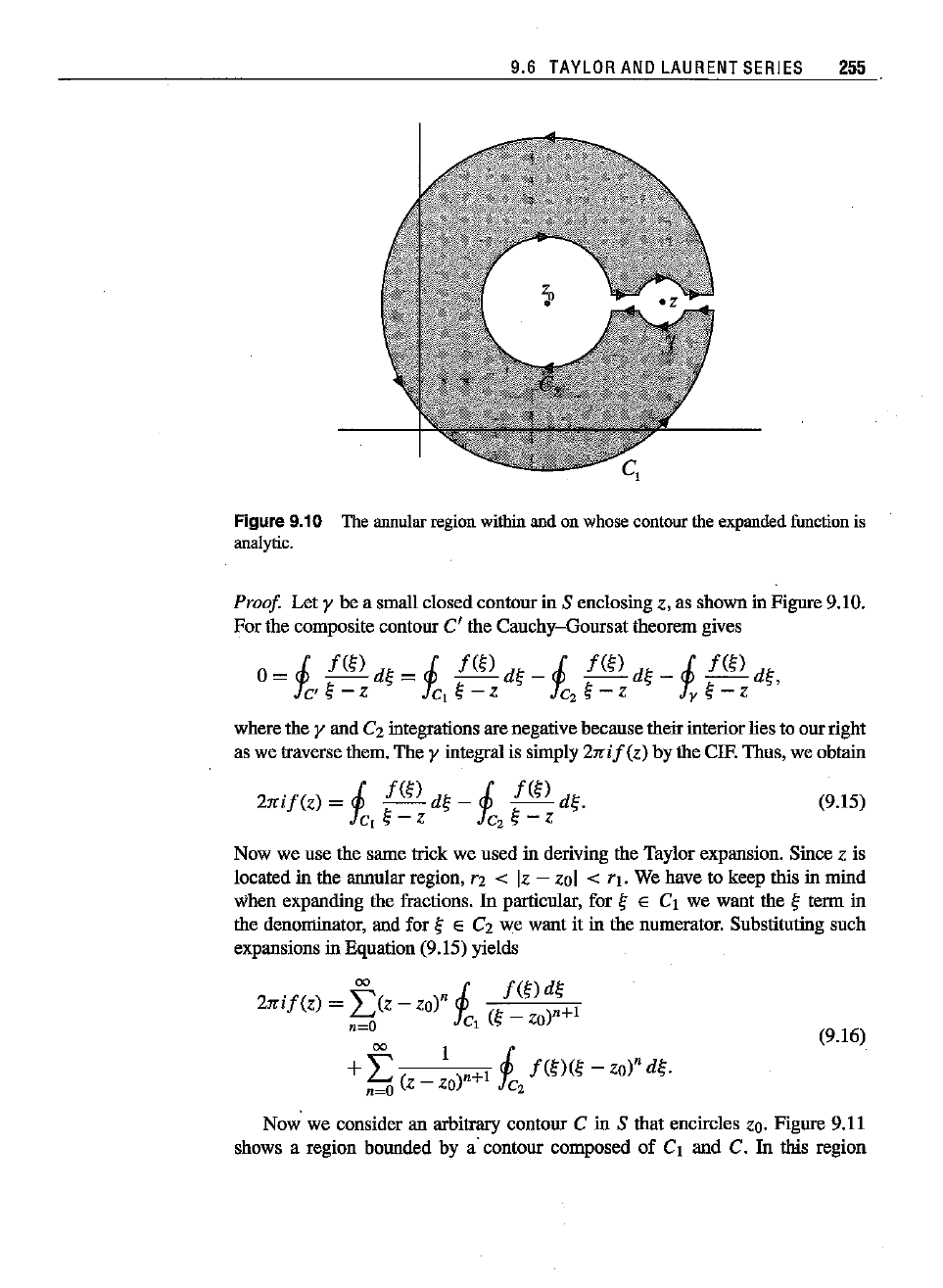
(9.15)
9.6
TAYLOR
AND
LAURENT
SERIES
255
Figure9.10 The
annular
region
within
andon whose
contour
the
expanded
function
is
analytic.
Proof
Let Ybe a small closedcontour in S enclosing z, as shown in Figure 9.10.
For
the composite contour
C'
the Cauchy-Goursat theorem gives
0=
J
f(~)
d~
= J
f(~)
d~
_ J
f(~)
d~
_ J
f(~)
d~,
Yc'
~
- Z
YCI
~
- Z
Yc,
~
- z
r,
~
-z
where the y and C2 integrations are negativebecause their interiorlies to our right
as we traverse them. The
y integral is simply 2rr:if(z) by the CIF. Thus,we obtain
2rr:if(z) = J
f(~)
d~
_ J
f(~)
d~.
YCI
~
- Z
Yc,
~
- z
Now we use the same trick we used in deriving the Taylor expansion. Since z is
located in the annular region,
ri < [z -
zol
<
rl.
We have to keep this in mind
When expanding the fractions. In particular, for
~
E CI we want the
~
term in
the denominator, and for
~
E C2 we want it in the numerator. Substituting such
expansions in Equation (9.15) yields
00
i
f(~)d~
2rr:if(z) =
I:(z
- zo)"
(~_
)n+l
n=O Cl
zo
00
I i
+
I:
( )n+l
f(;)(~
-
zo)"
d~.
n=Oz-zo
C2
(9.16)
Now we consider an arbitrary contour C in S that encircles
zoo
Figure 9.11
shows a region bounded by a' contour composed
of
CI and C. In this region
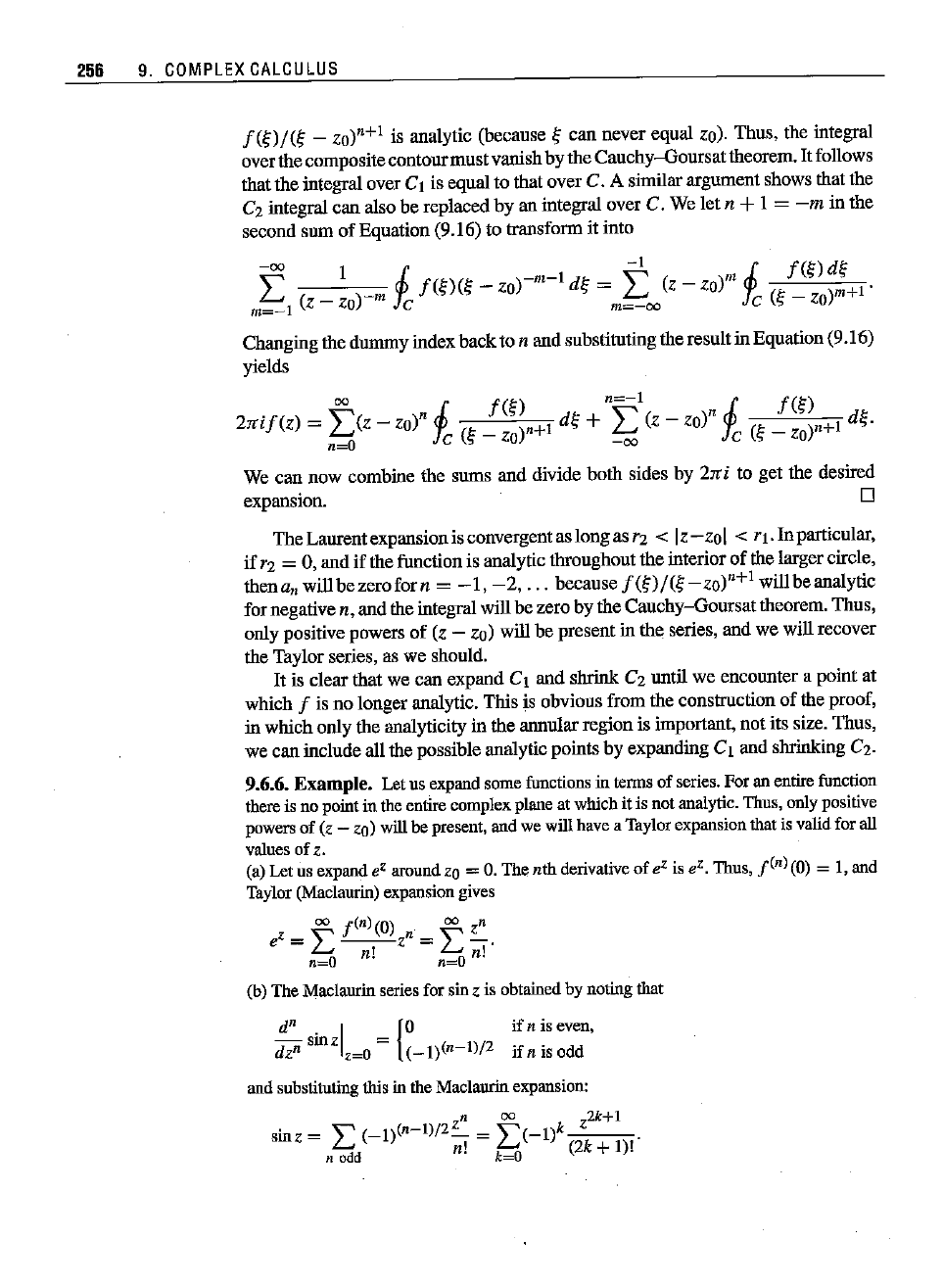
256 9.
COMPLEX
CALCULUS
1(1;)/(1;
- zo)n+l is analytic (because I; can never equal zo). Thus, the integral
overthe compositecontourmust vanish bythe Cauchy-Goursattheorem.
It
follows
that the integral over C
1 is equal to that over C. A similar argument shows that the
C2 integral can also be replaced by an integral over C. We let
n +1 =
-m
iu the
second sum of Equation (9.16) to transform it into
f: 1 m
J.
1(1;)(1;
-
zo)-m-l
dl; = f (z - zo)m
J.
1(1;)
~:+1
.
m~-1
(z - zo)
1'c
m=-oo
1'c
(I; - zo)
Changingthe dummy index backto n and substitutingthe resultin Equation(9.16)
yields
00
i 1(1;)
n=-1
i 1(1;)
2:n:i/(z) =
L(z
- zo)" (I; _ )n+l dl; + L (z - zo)" (I; _ )n+l dl;.
n=O C
zo
-00
c
zo
We can now combine the sums and divide both sides by
2:n:
i to get the desired
expansion. D
The Laurentexpansionisconvergeutas loug
as'2
< Iz-
Zo
I <
'I.
Iu particular,
if'2
= 0, and if the function is analytic throughout the interior of the larger circle,
then
anwill be zero
forn
=
-1,-2,
...
because1(1;)/(1;
_zo)n+l
will be analytic
for negative n, and the integral will be zero by the Cauchy-Goursattheorem. Thus,
ouly positive powers of (z - zo) will be present in the series, and we will recover
the Taylor series, as we should.
It
is clear that we can expand CI and shrink C2 until we encounter a poiut at
which I is no longer analytic. This is obvious from the constructiou of the proof,
in which ouly the analyticity in the annular region is important, not its size. Thus,
we can include all the possible analytic points by expanding CI and shrinking
C2.
9.6.6. Example. Letus
expand
some
functions
in tenusof
series.
Foran
entire
function
there
is nopointin the
entire
complex
plane
atwhichit is not
analytic.
Thus,
only
positive
powers
of (z - zo) willbe
present,
andwewill havea
Taylor
expansion
that
isvalidforall
values
ofz.
(a)Let us
expand
e
Z
around
20=
O.
Thenth
derivative
of e
Z
is e
Z
•
Thus,
j(n)(O)
= 1,and
Taylor
(Maclaurin)
expansion
gives
00
tIn)
(0)
00
zn
e'=
L--z
n
=
L-'
n=O
n!
n=O
n!
(b)The
Maclaurin
series
forsinz is
obtained
by
noting
that
d
n
.
I
{O
ifn
is even,
-r-r-smz =
dz
n
,~o
(_I)(n-I)/2
ifnisod<!
and
substituting
thisin the
Maclaurin
expansion:
n
00
2k+l
sinz = L
(_I)(n-I)/2~
=
L(-I)k
z .
n odd n!
k~O
(2k +1)1
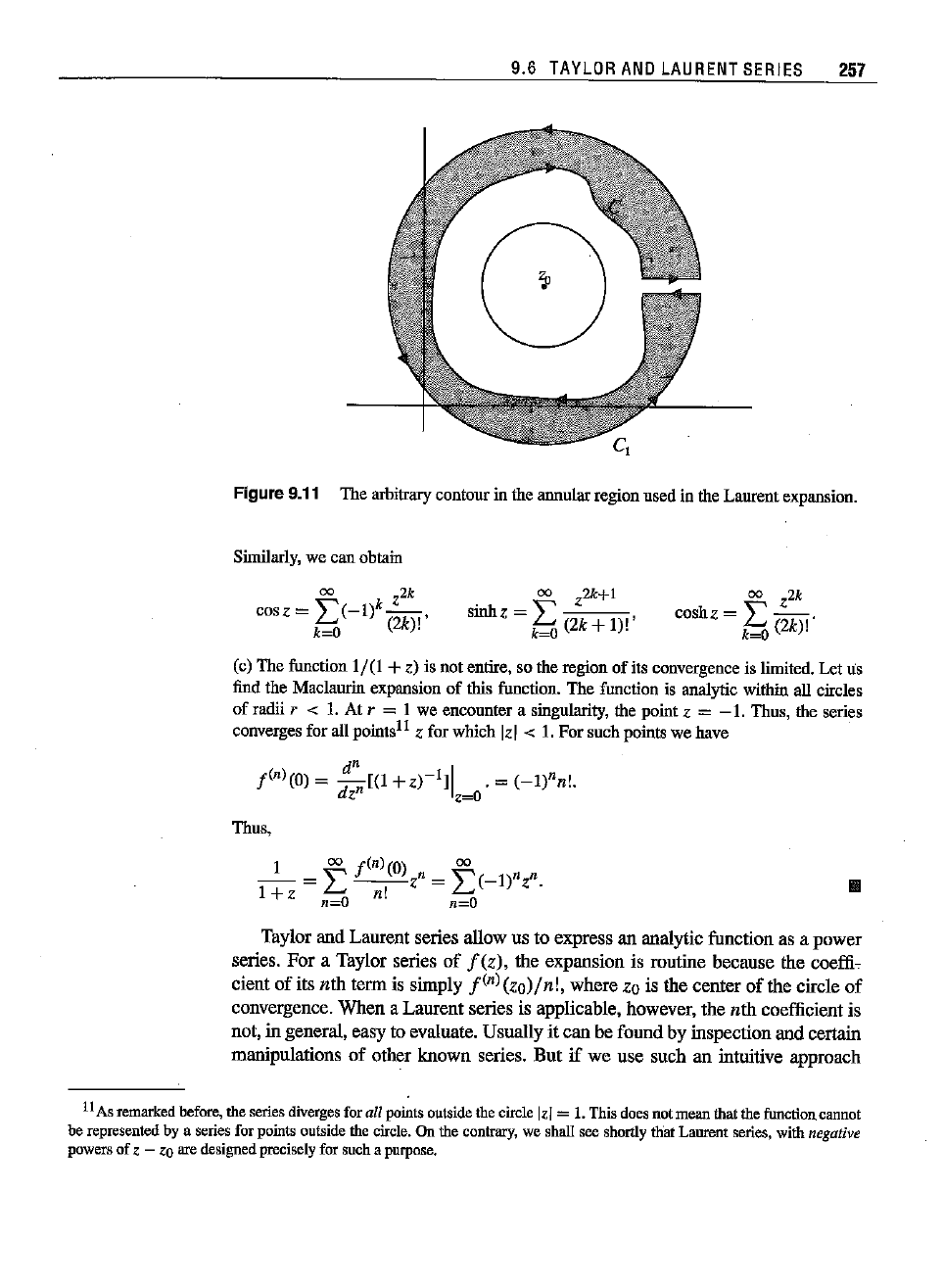
9.6
TAYLOR
AND
LAURENT
SERIES
257
Figure9.11 The
arbitrary
contour
inthe
annular
regionusedinthe
Laurent
expansion.
Similarly,
we can
obtain
00
Z2k
cosz =
{;,(_I)k
(Zk)!'
00
Z2k+l
sinhz =
(;,
""(Z"-k-+--'I'""')!'
00
Z2k
coshz =
I:
(Zk "
k~O
).
(c)The
function
1/(1 +z) is not
entire,
sotheregionof its
convergence
is
limited.
Letus
find
the
Maclaurin
expansion
of this
function.
The
function
is
analytic
within
all circles
of
radii
r < 1. At r = 1 we
encounter
a
singularity,
thepointz =
-1.
Thus,the series
converges
forallpointsl! z forwhich[z] < 1.Forsuch
points
we have
d
n
I
/(n)(O)
=
-[(I
+z)-I]
. =
(_I)nnL
dz
n
z=o
Thus,
_1_
= f
/(n)
(0)z" =
f(-I)nZn.
l+z
n=O n! n=O
III
Taylor and Laurent series allow us to express an analytic function as a
power
series.
For
a Taylor series
of
!(Z),
the expansion is routine because the coeffi-
cient
of
its
nth
term is simply
!(n)(zo)/nl,
where zo is the center
of
the circle
of
convergence.
When
a Laurent series is applicable, however,
the
nth
coefficient is
not, in general, easyto evaluate. Usually it
can
be found by inspection and certain
manipulations
of
other
known
series.
But
if
we
use
such an intuitive approach
11
As
remarked
before,
theseries
diverges
forall
points
outside
thecircle
lz!
= 1. Thisdoesnotmean
that
the
function
cannot
be
represented
by a seriesforpoints
outside
thecircle.Onthe
contrary,
we shallsee
shortly
that
Laurent
series,withnegative
powers
ofz - zearedesigned
precisely
forsucha
purpose.
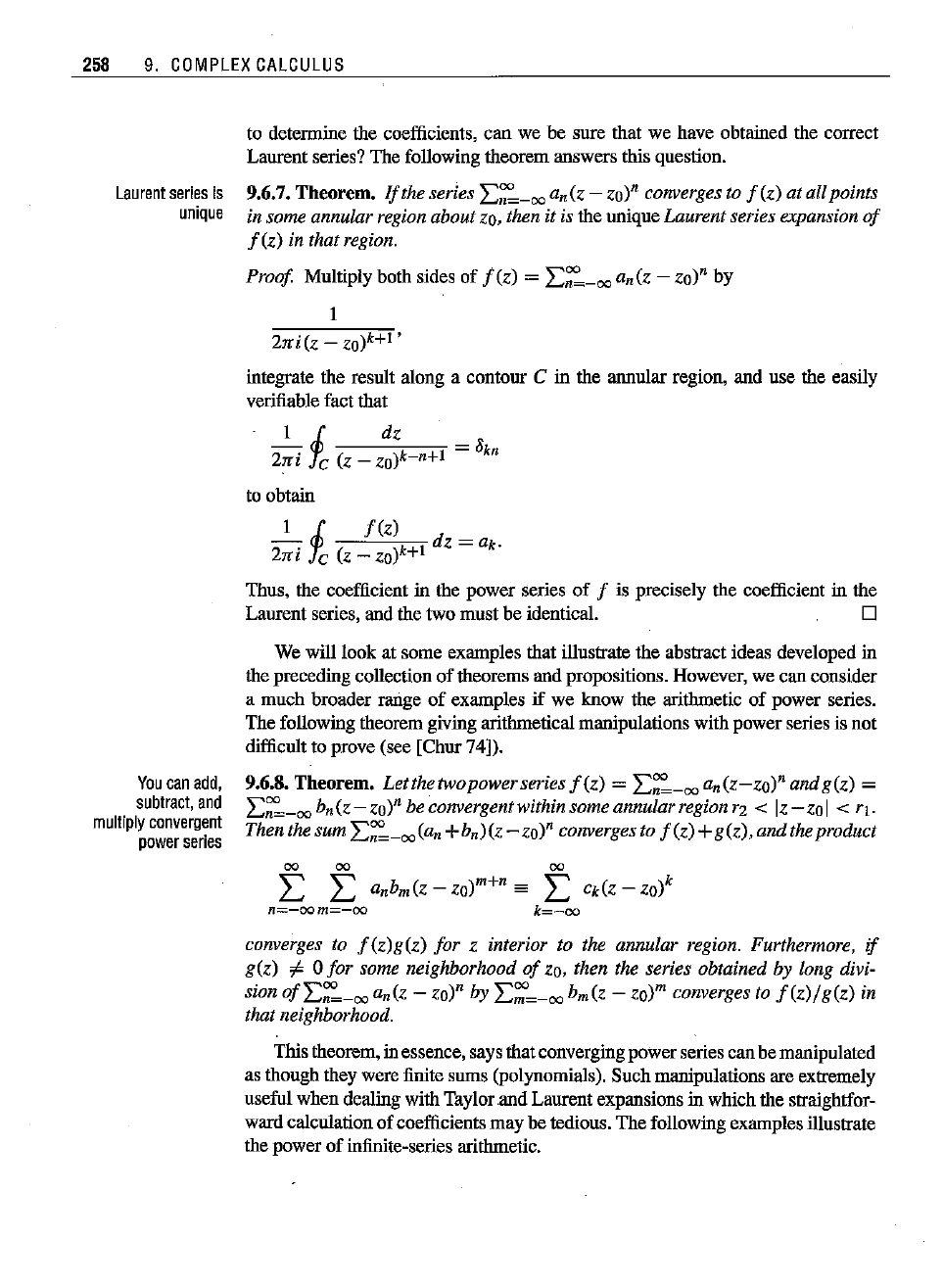
258 9.
COMPLEX
CALCULUS
n+l
= 8kn
Laurent
series
is
unique
You
can
add,
subtract,
and
multiply
convergent
power
series
to determine the coefficients, can we be sure that we have obtained the correct
Laurent series? The following theorem answers this question.
9.6.7. Theorem.
If
the series
L~-oo
an(z - zo)n converges to
fez)
at all points
insome
annular
region
about
zo.
then
it isthe
unique
Laurent
series
expansion
of
fez)
in that region.
Proof
Multiply both sides of f (z) =
L~-oo
an(z - zo)n by
1
211:i(z
- zo)k+!'
integrate the result along a contour C in the annular region, and use the easily
verifiable fact that
1 J dz
211:i
f
c
(z -
zo)k
to obtain
I J
fez)
211:i
fc (z_ zo)k+! dz = ar.
Thus, the coefficient in the power series of
f is precisely the coefficient in the
Laurent series, and the two must be identical. 0
We will look at some examples that illustrate the abstract ideas developed in
thepreceding collectionof
theorems
and
propositions.
However,
we canconsider
a much broader range
of
examples
if
we know the arithmetic of power series.
The following theorem giving arithmetical manipulations with power series is not
difficult to prove (see [Chur 74]).
9.6.8. Theorem.
Letthetwopowerseriesf(z)
=
L~_ooan(z-zo)nandg(z)
=
L~-oo
b
n
(z - zo)n be convergent within some annularregion r2 < [z- zoI< TJ·
Then the sum
L~-oo
(an
+bn)(z
- zo)n converges to f (z)+g(z),and theproduct
00 00 00
L L anbm(z -
zo)m+n
==
L
Ck(Z
-
ZO)k
n=-oo
m=-oo
k=-QO
converges to
f(z)g(z)
for Z interior to the annular region. Furthermore, if
g(z)
i'
0 for some neighborhood
of
zo.
then the series obtained by long divi-
sion
ofL~_ooan(Z
-
eo)"
by
L:'=-oo
bm(z - zo)" converges to
f(z)/g(z)
in
that neighborhood.
This theorem, inessence, says that converging power series canbe manipulated
as though they were finite sums (polynomials). Such manipulations are extremely
useful when dealing with Taylor.andLaurentexpansions in which the straightfor-
ward calculation of coefficients may be tedious. The following examples illustrate
the power
of
infinite-series arithmetic.
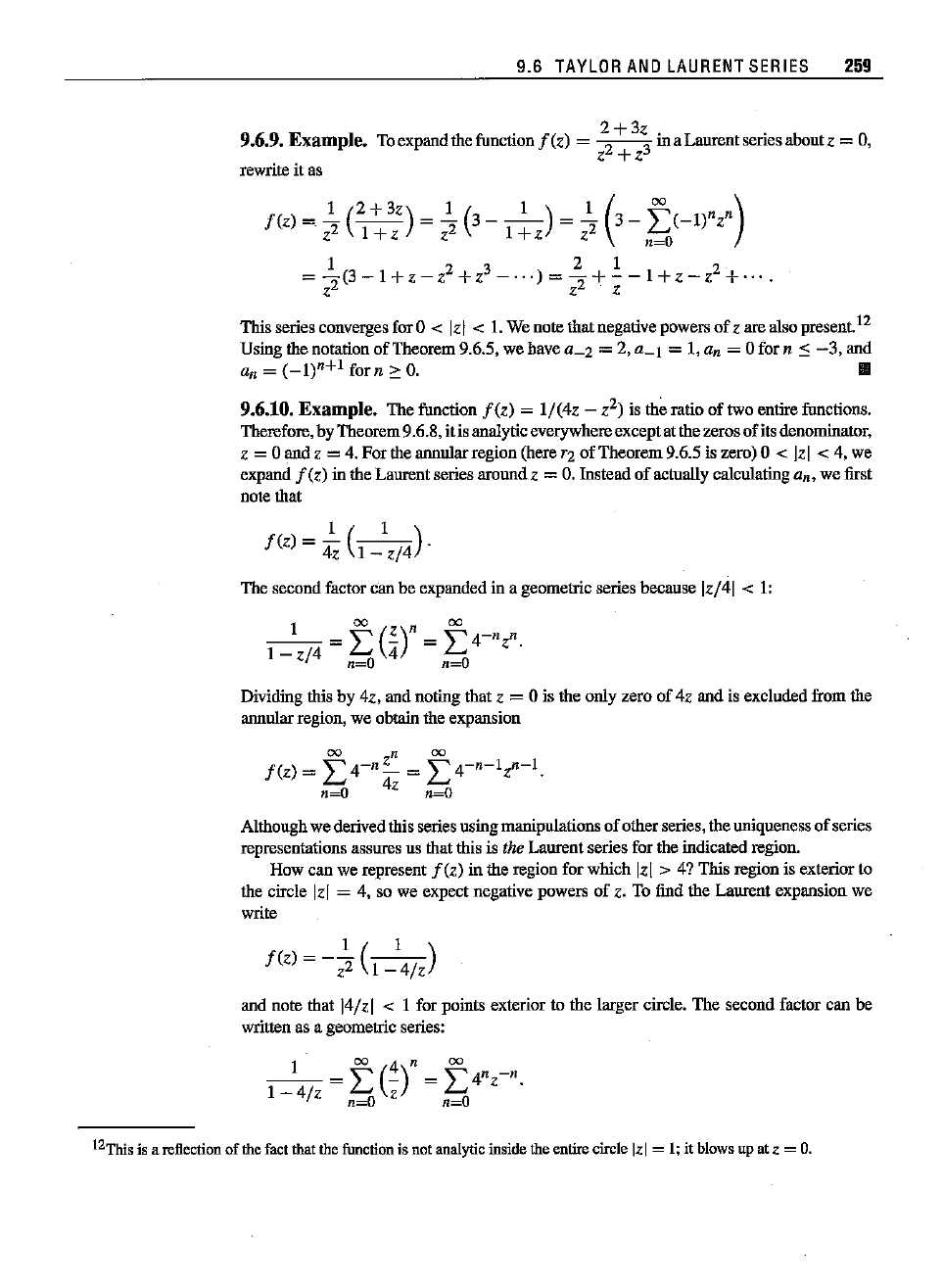
9.6.9.
Example.
rewriteit as
9.6
TAYLOR
AND
LAURENT
SERIES
259
Toexpandthefunctionf(z) =
22+3~
inaLaurentseriesaboutz =0,
z
+z
fez) =
~
(2+
3Z) =
~
(3
__
1_)
=
~
(3
_
~(_I)nZn)
Z
21+Z
z2
I+z
Z2
L..
n=O
1 2 3 2 1 2
=-(3-I+z-z
+Z
-···)=-+--I+z-z
+
....
Z2 Z2 . Z
Thisseriesconverges for0 <
[z]
< 1.Wenotethatnegativepowersof z arealsopresent.
12
Using the notation
of
Theorem 9.6.5, we have
a_2
= 2,
a_I
= 1, an = 0 for n
:::s
-3,
and
an = (_1)n+1
forn
'"
O.
III
9.6.10.
Example.
The function fez) = 1/(4z - z2) is the ratio of two entire functions.
Therefore,by Theorem9.6.8,
itis
analyticeverywhereexceptat the zeros
of
its denominator,
Z = 0 and z =4. Fortileannularregion (herer2 ofTheorem9.6.5is zero)0 < lel < 4, we
expand
f(z)
in the Laurent series around z =
O.
Instead of actually calculating an, we first
notethat
fez) =
:z
(I
_l
z
/
4)·
The second factor can be expanded in a geometric series because Iz/41 < 1:
l
OO
n
00
__
'"
(~)
_
'"
4-n
n
1 _
z/4
-
L..
4 -
L..
z.
n=O
n=O
Dividing this by
cz,
and noting that z = 0 is the only zero of 4z and is exclnded from the
annularregion, we obtain the expansion
Althoughwe derivedthis series usingmanipulations
of
otherseries, the uniqueness
of
series
representations assures us that this is the Laurent series for the indicated region.
How can we represent
fez)
in the region for which
Iz[
> 4? This region is exterior to
the circle
lel
= 4, so we expect negative powers
of
z. To find the Laurent expansion we
write
fez) = -
z;
C_1
4
/J
and note that ]4/zl < 1 for points exterior to the larger circle. The second factor can be
written as a geometric series:
12This is a reflection
of
the fact that the function is not analytic inside the entire circle
lz!
= 1; it blows up at z = O.
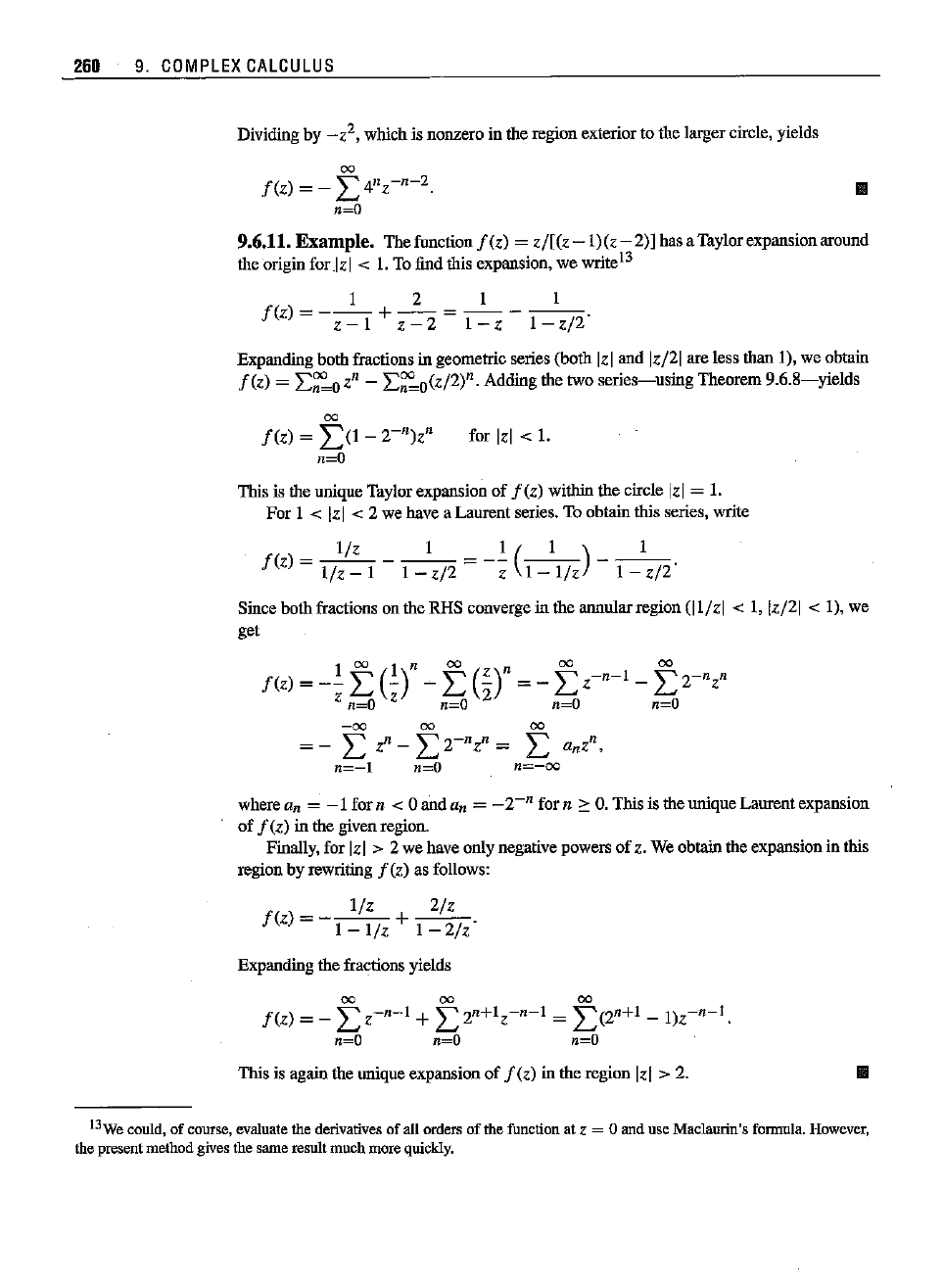
260 9.
COMPLEX
CALCULUS
Dividingby
_z2,
whichis
nonzero
intheregion
exterior
tothe
larger
circle,yields
00
f(z)
= -
I>"z-n-2
n=Q
11II
9.6.11. Example. The function
fez)
= z([(z
-1)(z-2)]
has a Taylor expansion around
theoriginIorlz] < 1.To
find
this
expansion,
we write
13
1 2 1 1
f(z)
=--1
+-2
=
-1
---1
(2·
z-
z-
-z -z
Expanding both fractions in geometric series (hoth [z]and Iz(21are less than 1), we ohtain
fez)
=
L~o
z" -
L~O(z(2)n.
Adding the two
series-nsing
Theorem
9.6.8-yie1ds
00
fez)
=
L(l-
2-")zn
n=O
for Izl < 1.
This is the unique Taylor expansion
of
fez)
within the circle Izi = 1.
For1 <
Izi
-c 2we havea Laurent
series.
To
obtain
this
series,
write
l(z
1 1 (
1)
1
fez)
=
l(z
- 1 - 1 -
z(2
=
-z
1 -
l(z
- 1 -
z(2·
Since hoth fractions on the RHS converge in the annuiarregion (11(zl < 1, Iz(21 < 1), we
get
100
In
00
n
00 00
fez)
= -zL
(z)
- L m= -
Lz-
n-
I
-
L2-
nz
n
n=D n=O n=O n=O
-00
00 00
=-
L z">
Lz-nz
n
= L
anZ
n
,
n=-l
n=O
n=-oo
where
an =
-1
forn < 0 and an =
_Z-n
farn
:::
O.
Thisis the unique Laurentexpansion
of f (z) in thegivenregion.
Finally,
for
Izl
> 2 we
have
only negative
powers
ofz. We
obtain
the
expansion
inthis
region hy rewriting f (z) as follows:
l(z
2(z
fez)
=
-1
_
l(z
+ 1 -
2(,
Expanding
the
fractions
yields
00 00 00
fez)
= - L
z-n-I
+ L 2
n
+
1z-
n-
1
=
L(2n+l
-
1)z-n-1.
n=O n=O n=O
Thisis
again
the
unique
expansion
of
f(z)
in theregion[z] > 2.
11II
13We
could,of
course,
evaluate
the
derivatives
of all
orders
of the
function
atz = 0 anduse
Maclaurin's
formula.
However,
the
present
methodgivesthesameresultmuchmore
quickly.
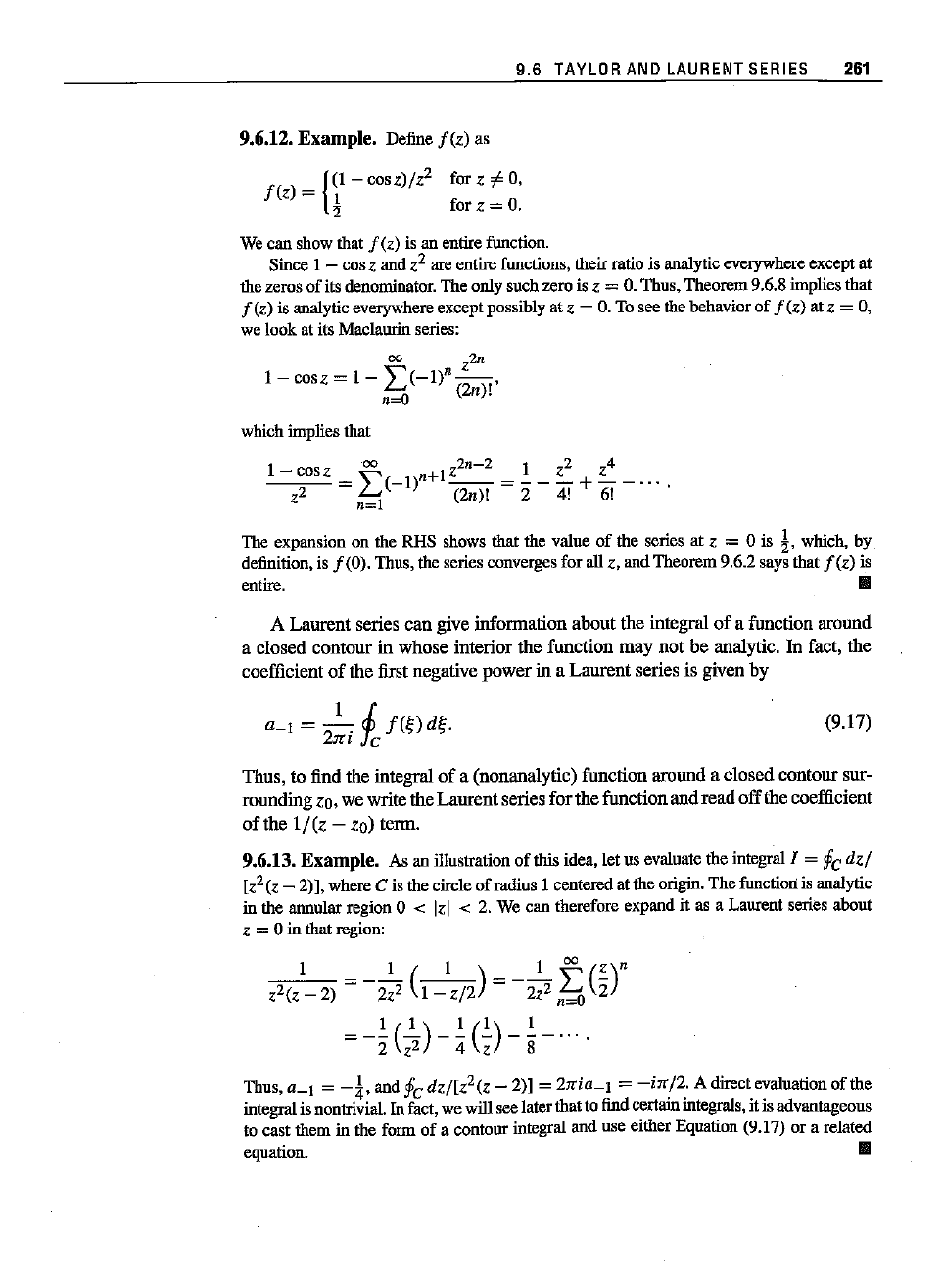
9.6 TAYLOR
ANO
LAURENT
SERIES
261
9.6.12.
Example.
Definef (z) as
f
{
(I - cosz)/z2 for z
'"
0,
(z) = 1
2 for z =
O.
Wecanshow
that
f(z)
is an
entire
function.
Since 1 - cosZ andz2
are
entire
functions,
their
ratio
is
analytic
everywhere
exceptat
thezerosof its
denominator.
Theonlysuchzerois z =
O.
Thus,
Theorem
9.6.8
implies
that
f(z)
is analyticeverywhere exceptpossiblyatz =
O.
Toseethebehaviorof
f(z)
atz = 0,
we lookatits
Maclaurin
series:
00
z2n
1-
cosz =
1-
L(-I)n_-,
n~O
(2n)!
whichimplies
that
The expansion on the RHS shows
that
the value of the seriesat z = 0 is !'
which,
by
definition, is f(O). Thus,the seriesconverges for all z, andTheorem9.6.2saysthat
f(z)
is
entire.
III
A Laurent series
can
give information about the integral
of
a function around
a closed contour in whose interior the function may
not
be analytic. In fact, the
coefficient
of
the first negative
power
in a Laurent series is given by
a_I
= .2., J
f(~)
d~.
21f1
rc
(9.17)
Thus, to find
the integral
of
a (nonanalytic) function around a closed contour sur-
rounding
zo,
we writethe Laurentseries for the functionand read
off
the coefficient
of
the
I/(z
-
zo)
term.
9.6.13.
Example.
As an illustrationof thisidea.Iet us evaluatethe integralI =
Pc
dz/
[z2(z - 2)], whereC is the circleof radius I centeredatthe origin.Thefunctionis analytic
in the
annular
region
0 < [z] < 2. Wecan
therefore
expand
it as a
Laurent
series
about
z =0 in thatregion:
I I (
I)
I
00
(z)n
z2(z - 2) = - 2z
2
I -
z/2
= - 2z
2];
2:
=-~
C2)
-
~
G)
-
~
-
....
Thus,
LI
=
-1,
and
Pc
dz/[z2(z
- 2)] = 21tia_l =
-i1t/2.
A directevaluationof the
integral
is
nontrivial.
In
fact,
wewill see
later
that
to
find
certain
integrals,
itis
advantageous
to cast them in the form of a contourintegraland use either Equation (9.17) or a related
equation. II
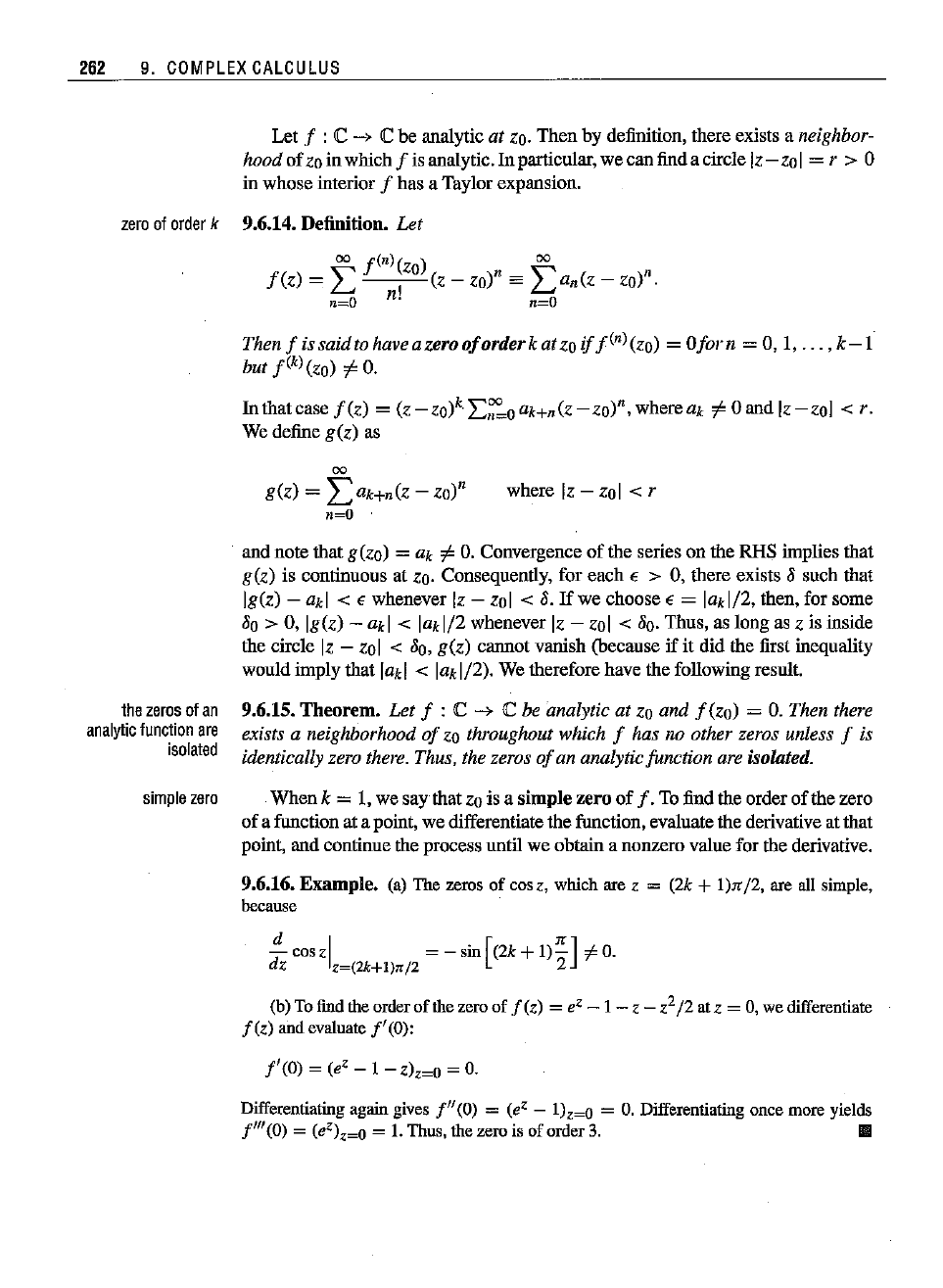
262
9.
COMPLEX
CALCULUS
Let f : C
->
C be analytic
at
zoo
Then by definition, there exists a neighbor-
hood
ofzo
in which f is analytic.
In
particular, we can find a circle Iz-zol = r > a
in whose interior f has a Taylor expansion.
zero
of
order
k 9.6.14. Definition.
Let
00
f(n) (eo)
00
f(z)
= L I (z -
zo)"
es
Lan(Z
- zn)".
n=O
n.
n=O
Then f is saidto have azero
oforderk
atzo
iff(n) (zn) =
Oforn
= 0, 1,
...
,
k-l
but
f(k)
(zo)
i'
o.
In
that case
f(z)
= (z -
ZO)k.
I:~o
ak+n(Z- zo)n, where ak
i'
aand [z
-zol
< r.
We define
g(z)
as
00
g(z)
= L ak+n(z - zo)"
n=O
where [z -
zol
< r
the
zeros
ofan
analytic
function
are
isolated
simple
zero
and note that g(zo) = ak
i'
O.
Convergence of the series on the RHS implies that
g(z)
is continuous at
ZOo
Consequently, for each E > 0, there exists 8 such that
Ig(z) - akl < E whenever [z -
zol
<
8.lfwe
choose E = lakl/2, then, for some
80>
0, Ig(z) - akl < lakl/2 whenever [z - zo] < 80.Thus, as long as z is inside
the circle [z - zn]
< 80,
g(z)
cannot vanish (because if it did the first inequality
would imply that
lakl < lakl/2). We therefore have the following result.
9.6.15.
Theorem.
Let
f : C
->
iC
be analytic at zo
and
f (zo) =
O.
Then there
exists a neighborhood
of
zo throughout which f has no other zeros unless f is
identically zero there. Thus, the zeros
of
an analyticfunction are isolated.
Whenk = 1, we say that zo is a simple zero
of
f.
To find the order of the zero
of a function at a point, we differentiate the function, evaluate the derivative at that
point,
and
continue
the
process
untilwe
obtain
a
nonzero
valueforthe
derivative.
9.6.16.
Example.
(a) The zerosof cosz, which are z = (2k + 1),,/2, are all simple,
because
d
d
coszl = - sin[(2k +
I)::]
'"
O.
z
z~(2k+I)n/2
2
(b)Tofindtheorderof thezeroof f (z) = e
Z
- 1- z -
z2/2
atz = 0, wedifferentiate
f(z)
andevaluate f'(O):
f'(O) = (e
Z
-I-z)z=o
=
O.
Differentiating
again
gives f"(O) = (e
Z
-
l)z=O =
O.
Differentiating
once
more
yields
fm
(0) =
(eZ)z~o
=
I.
Thus,thezero is oforder3.
III
